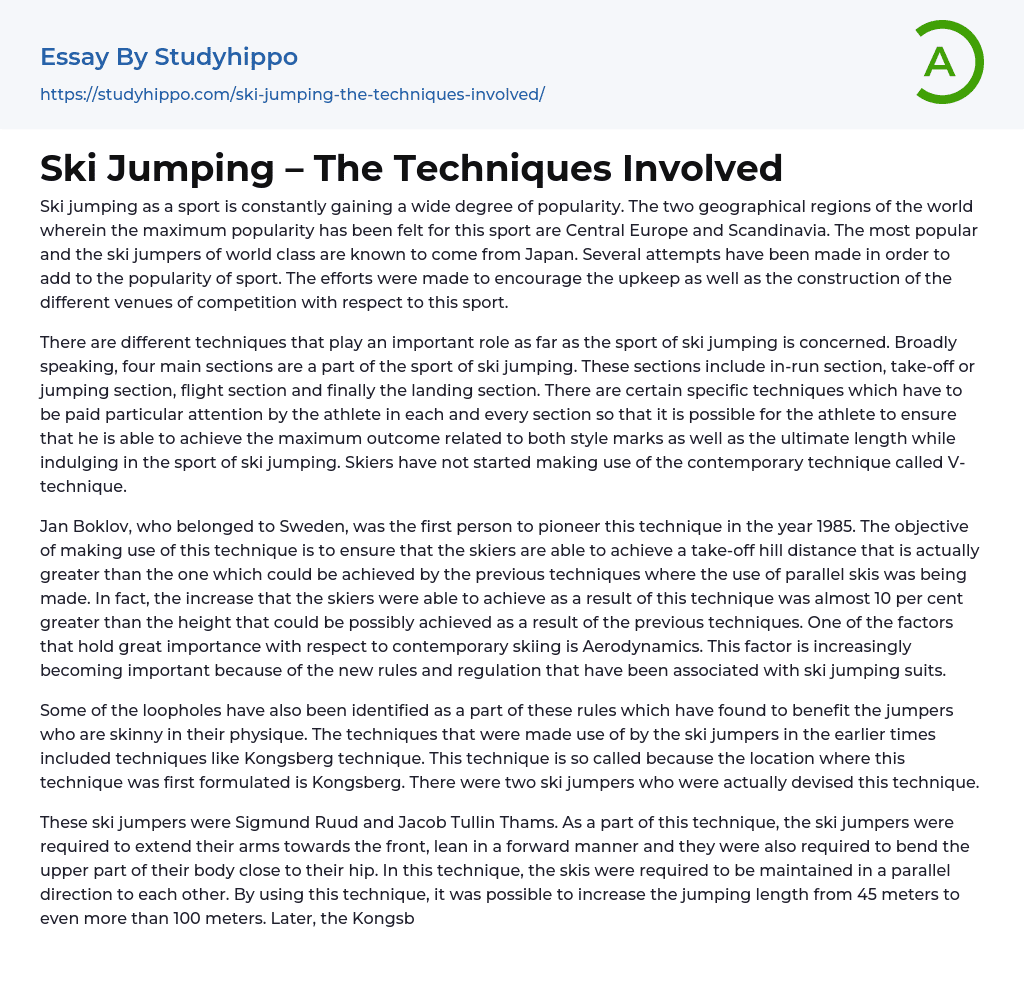Ski jumping as a sport is constantly gaining a wide degree of popularity. The two geographical regions of the world wherein the maximum popularity has been felt for this sport are Central Europe and Scandinavia. The most popular and the ski jumpers of world class are known to come from Japan. Several attempts have been made in order to add to the popularity of sport. The efforts were made to encourage the upkeep as well as the construction of the different venues of competition with respect to this sport.
There are different techniques that play an important role as far as the sport of ski jumping is concerned. Broadly speaking, four main sections are a part of the sport of ski jumping. These sections include in-run section, take-off or jumping section, flight section and finally t
...he landing section. There are certain specific techniques which have to be paid particular attention by the athlete in each and every section so that it is possible for the athlete to ensure that he is able to achieve the maximum outcome related to both style marks as well as the ultimate length while indulging in the sport of ski jumping. Skiers have not started making use of the contemporary technique called V-technique.
Jan Boklov, who belonged to Sweden, was the first person to pioneer this technique in the year 1985. The objective of making use of this technique is to ensure that the skiers are able to achieve a take-off hill distance that is actually greater than the one which could be achieved by the previous techniques where the use of parallel skis was being made. In fact, th
increase that the skiers were able to achieve as a result of this technique was almost 10 per cent greater than the height that could be possibly achieved as a result of the previous techniques. One of the factors that hold great importance with respect to contemporary skiing is Aerodynamics. This factor is increasingly becoming important because of the new rules and regulation that have been associated with ski jumping suits.
Some of the loopholes have also been identified as a part of these rules which have found to benefit the jumpers who are skinny in their physique. The techniques that were made use of by the ski jumpers in the earlier times included techniques like Kongsberg technique. This technique is so called because the location where this technique was first formulated is Kongsberg. There were two ski jumpers who were actually devised this technique.
These ski jumpers were Sigmund Ruud and Jacob Tullin Thams. As a part of this technique, the ski jumpers were required to extend their arms towards the front, lean in a forward manner and they were also required to bend the upper part of their body close to their hip. In this technique, the skis were required to be maintained in a parallel direction to each other. By using this technique, it was possible to increase the jumping length from 45 meters to even more than 100 meters. Later, the Kongsberger technique was modified and as a part of this modified technique, the arms were placed in a backward direction in the direction of the hips with an objective of achieving a closer lean.
- Accounting essays
- Marketing essays
- Automation essays
- Business Cycle essays
- Business Model essays
- Business Operations essays
- Business Software essays
- Corporate Social Responsibility essays
- Infrastructure essays
- Logistics essays
- Manufacturing essays
- Multinational Corporation essays
- Richard Branson essays
- Small Business essays
- Cooperative essays
- Family Business essays
- Human Resource Management essays
- Sales essays
- Market essays
- Online Shopping essays
- Selling essays
- Strategy essays
- Management essays
- Franchising essays
- Quality Assurance essays
- Business Intelligence essays
- Corporation essays
- Stock essays
- Shopping Mall essays
- Harvard Business School essays
- Harvard university essays
- Trade Union essays
- Cooperation essays
- News Media essays
- Waste essays
- Andrew Carnegie essays
- Inventory essays
- Customer Relationship Management essays
- Structure essays
- Starting a Business essays
- Accounts Receivable essays
- Auditor's Report essays
- Balance Sheet essays
- Costs essays
- Financial Audit essays
- International Financial Reporting Standards essays
- Tax essays
- Accountability essays
- Cash essays
- Principal essays




